Looking Back to Look Forward: The Next Ten Years of Spectrum Policy
Looking Back to Look Forward: The Next Ten Years of Spectrum Policy
Tuesday, November 13, 2012; 1:00 - 6:00 PM
@ Pew Research Center, Washington, DC
Co-Sponsored by Silicon Flatirons Center - A Center for Law, Technology, and Entrepreneurship at the University of Colorado, CTIA - The Wireless Association and Public Knowledge
In Cooperation With the Federal Communications Bar Association and IEEE-USA
The regulatory foxtrot - slow, slow, quick, quick, slow - means that participants in the spectrum policy dance need to keep an eye both their current and future partners. Multiple cycles line up this year: it's a century since the sinking of the Titanic and the 1912 Radio Act, ten years since the FCC Spectrum Policy Task Force Report (SPTFR), and the end of a four-year Administration that saw the FCC's National Broadband Plan, a Presidential Memorandum calling for 500 MHz of spectrum to be found for wireless broadband use, and a report of the President's Council of Advisors on Science and Technology (PCAST) about realizing the full potential of government-held spectrum.
It is a time when pressure on spectrum allocations keeps growing due to the drumbeat of new broadband wireless applications, a crowded dance floor with a growing diversity and density of conflicting radio operations, and a crescendo of technologies such as smarter radios and heterogeneous networks. This presents an opportunity to look back at lessons learned, and prepare for challenges of the next four and ten, if not a hundred, years.
Panel 1: The Promise and Problems of Strategic Plans: From the Spectrum Policy Task Force to the PCAST Report
A decade ago, an intensive multi-disciplinary review culminated in ground-breaking staff report that is still often quoted. Recent years have seen similarly ambitious strategic plans from the FCC and the White House: the National Broadband Plan, the President's Memo, and the PCAST report. What lessons can be learned about strategic spectrum planning from the impact and unfinished business of the SPTFR? How should these lessons be applied to the current crop of recommendations?
Panel 2: Reforming US Spectrum Management: Sharing, Reallocation and Other Options
The FCC's National Broadband Plan and the President's spectrum initiative laid out aggressive goals for spectrum reallocation to commercial mobile broadband, and the PCAST report recommended sweeping, long-term reforms of government spectrum management. Sharing has become a serious option. What are the strengths and weaknesses of these proposals; what needs to be added or taken away? What are the prospects for improving the transition from old to new ways of using spectrum for federal and non-federal users.
Panel 3: The View Ahead: Technology opportunities
Regulatory discussions are informed by technology trends, and wireless research continues to open up new policy possibilities. What are the long-term technology trends and constraints that will drive spectrum policy over the next ten years? This panel will lay out what to expect, and when, as we move to ever-denser packing of bands.
[Your blogger is speaking on Panel 1]
NAB: Cognitive Radio is Effective Enough to Allow Sharing of Critical Government Frequencies - But Not Good Enough to Protect Broadcast TV
So you can see how surprised and excited I was to get the e-mail shown at left from Dennis Wharton, Executive Vice President of Communications at NAB, with the subject line “The spectrum crisis is completely avoidable”. We certainly want to avoid this crisis and I was delighted to read what NAB’s new solution was. The message begins with “I thought you might find of interest this article from The New York Times about technological solutions to increase the efficiency of wireless mobile broadband networks.” The Times article was mainly about the PCAST spectrum report that SpectrumTalk readers read about here on May 28th. In the article Mr. Wharton was kind enough to recommend was a discussion of how effective cognitive radio technology now is and the statement “For example, if the government has reserved some spectrum for use at an Air Force bombing range, but no bombing is happening on a particular day, cognitive radio could allow a phone to sense the open channel and switch to it.”
Mr. Wharton, let me explain why it is much easier for a cognitive radio to sense in TV white space whether there are usable TV signals than the case of sensing the presence of military signals:
- TV signals are generally on 24/7, they do not turn on and off at random times as military signals do.
- TV transmitters are firmly bolted to the ground in well defined locations.
- TV signals have a very precisely defined (in a public documentation) 6 MHz wide waveform with very precise frequency stability and timing. It is almost as if they were designed to be detected at much greater sensitivity than a consumer receiver. Indeed, FCC testing showed that they could be detected at a power level 35 dB less than the sensitivity of a TV receiver and better detectors are possible. In general military signals do not have waveforms that are known to the public. Thus the U-NII cognitive radio rules in 47 CFR 15.407(h)(2) require a “Radar Detection Function of Dynamic Frequency Selection” that knows nothing about the radar signal it is trying to detect since the military would no divulge the specific technical details of the radars in the band - a far cry from the well known ATSC signal in the TV band!
- If interference is caused to TV reception, it may be unfortunate but there are no permanent negative consequences - like death or injury. If there is interference to a military system the consequences could me more severe.
Based on the above, cognitive radios in the TV band raise far fewer issues than cognitive radios that try to detect the presence of military signals.
Since Mr. Wharton has concluded that cognitive radio technology has now advanced to the point that it can reliably detect the presence of military signals to allow broadband use of military bands when and where they are not in use, I assume that NAB must now endorse the technically simpler case of using of cognitive radios in the TV bands under similar terms.
I hope Mr. Wharton comes to the DySPAN 2012 Conference in Bellevue WA in October and explains NAB’s new view on cognitive radio. I’m sure he’ll get a standing ovation!
Proceedings of the IEEE Paper on Radio Spectrum Access Published
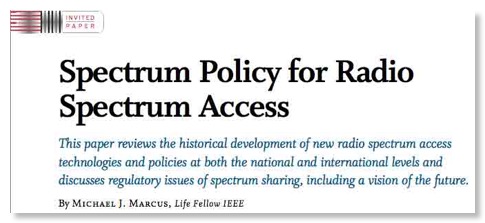
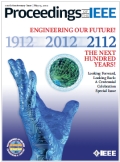
“A special 13 May centennial issue, published as the thirteenth issue of 2012, reviews 19 key technologies from three perspectives: the past, the present, and prospects for developments in the future. ”
The article is available for free to subscribers to IEEE Xplore. Here is the abstract:
Here also are the conclusions of the article:Classic spectrum management policies and regulations focused on unique frequency assignments for users to avoid intersystem interference. The growing demand for wireless communications along with the recognition that classic spectrum management leads to underutilized spectrum in time and spacehas resulted in interest in radio spectrum access techniques. Since spectrum use is highly regulated at the national and international levels, the status of regulatory policies is key to the implementation of new access technologies.
The major obstacle to RSA use has been incumbent users who fear interference and in some cases newcompetition. At times, RSA advocates have not been sensitive enough to these concerns and pragmatic in dealing with them. Incumbent spectrum users both have a significant stake in spectrum use as well as major influence in national and international policy fora. Spectrum policies that reward incumbents for supporting more intense use ofspectrum may be one method of making the interests of incumbents better aligned with goals of more intense spectrum use. While passive monitoring systems for determining spectrum availability are possible in some applications, active engagement of incumbents in realtime determination of spectrum availability will result in cooperative systems that both decrease incumbents’ legitimate concerns as well as maximize the amount of spectrum available for RSA for a given interference risk probability.
It is difficult to build cooperative systems as modifications to incumbent systems designed for exclusive spectrum use. Thus, standards and regulatory policies that encourage spectrum users to make data available on instantaneous spectrum use and expected changes in use would facilitate cooperative RSA systems and also help protect incumbent use.
If incumbent opposition can be moderated through cooperative RSA systems or if national and international regulators take a bolder approach in maximizing public interest in spectrum by insisting on spectrum access techniques that use the resource more intensively, then RSA will serve a key role in facilitating more intense spectrum use and its economic and societal benefits.
The 700 MHz LTE Public Safety Plan: Some Concerns

For all its flaws, the European nations now have TETRA as their public safety network core. But the previous Motorola so thoroughly orchestrated the dissing of TETRA in favor of their preferred P25 in order to maintain market hegemony , that the US ended up with neither system. (At one point Motorola - not really the same company that exists today with that name - even tried to use its ownership on a patent used in TETRA to prevent any use of TETRA in USA. The ongoing Docket 11-69 deals with the issue of any future use of this technology in the US, not just public safety.)
Two issues dealing with 700 MHz LTE for public safety don’t get much discussion, so I will review them here:
1) 700 MHz This band is comparable to one of the frequencies used for cellular telephony since the 1980s. Many of us think of cellular service as ubiquitous, but it really isn’t in terms of the land mass of the US. The map at right is the coverage area of VerizonWireless and there are certainly coverage gaps in rural areas, specially those with rugged terrain. 700 MHz has slightly better propagation than the 800 MHz cellular band, but that will not solve this problem. It is not clear if it is economically practical to cover the US with 700 MHz coverage even if the cellular industry shared infrastructure with the new public safety network. Public safety officers lives depend on ubiquitous communications. Statewide public safety agencies, as well has local and regional agencies in rugged terrain, often use the 30-50 MHz band what has much greater range than higher bands although suffers from reliability problems due to quirky propagation phenomenon and also attracts little 8th Floor interest. A ULS search reveals 15,849 current (nonfederal) public safety licenses in this long range band. (Note that Spectrum Dashboard does not cover this low policy interest band - so we can’t give you any maps.)

Now the nationwide public safety system could supplement the 700 MHz LTE systems with a more limited capability satellite (MSS) systems that provides connectivity where 700 MHz isn’t available. For example, the recently announced DeLorme inReach device uses the Iridium network and shows that limited emergency capability in isolated areas is available now at modest cost. But I have not seen any discussion about supplementing 700 MHz coverage with alternative media, such as MSS, for public safety agencies that will never have ubiquitous 700 MHz coverage in their territory. So how will the 15,849 present 30-50 MHz public safety licensees transition to the new 700 MHz system?
2) Voice over LTE Voice is an integral part of public safety communications now and in the foreseeable future. While using voice on an LTE system appears technical possible, it is not an operational reality. Last month, NetworkWorld quoted Verizon Vice President of Network Hans Leutenegger as saying that VZW “won't be deploying any voice over LTE (VoLTE) services on its network until late next year at the very earliest.” Public safety networks need not only voice, but voice with special features such as priorities, preemption, and network control by the commanders of first responders. These features are not operational as yet and it is not clear if the resources programmed for their development and testing are really adequate for the task - given the high reliability we owe our public safety officers.
More than a decade ago, the public safety community was greatly indebted to the old Motorola who invented this technology and shepherded it introduction into the public safety. Groups like APCO in the past showed their appreciation by allowing Motorola to manipulate their spectrum policy positions before FCC and they consistently opposed technical evolutions much more modest than which is involved here. Indeed, the fact that we are only now finishing the 20 year narrowband transition shows the effectiveness of this Motorola “partnership” with public safety that slowed technical progress while maintaining Motorola’s market share. The present Motorola Solutions no longer has the control of the old Motorola and others entities are trying to manipulate the public safety community for their own gains.
The fact that the public safety community generally seems happy with the present plan may indicate that the new manipulators have successfully filled the power vacuum left when Motorola was restructured. Hopefully the public safety community will become more cynical about being manipulated in the corporate interests of others and they will aggressively make sure their own interests are pursued in the development of the national wide interoperable system that is so critically needed.
White House Advisory Committee Recommends Major Changes to Federal Spectrum Use
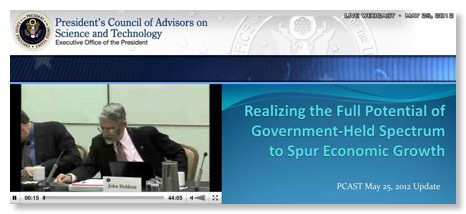
At its May 25th meeting the President’s Council of Advisors on Science and Technology, a White House advisory committee of top technical experts, endorsed a report from a subcommittee entitled “Realizing the Full Potential of Government-Held Spectrum to Spur Economic Growth”. The text of of the report has not been released to the public pending final editing and delivery to the President. However, there was a presentation at the PCAST meeting and below are two “slides” from the presentation.
The first slide to be discussed is below:

Its second point is to “state the policy of the U.S. government is to share underutilized spectrum”. It is pretty clear that that is not the present policy. I recall that during the drafting of the Spectrum Policy Task Force Report the NTIA staff had a temper tantrum on even mentioning that “interruptible spectrum” sharing of low average utilization federal spectrum might be considered. All reference to the topic in the context of federal spectrum was scribed from the report!
IRAC traditionalists will also not be very pleased with the 3rd point on sharing 1000 MHz with the private sector. I hope the report indicates that this can not be resolved by sharing 97-98 GHz!
Clay T. "Tom" Whitehead

The report recommends creating a “White House-based Spectrum Management Team” of senior Administration officials to work with NTIA. This would be a move in the right direction to give real Silicon Vally-style “adult supervision” to IRAC - the group that makes most spectrum management decisions without much accountability to anyone.
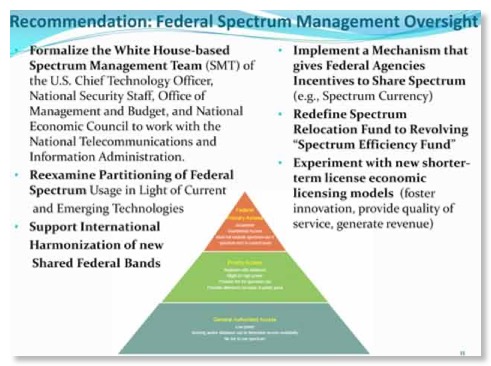
The report also recognizes the at present agencies have no incentive to cooperate with sharing and to be early adopters of sharing concepts. Thus it proposes to reward such early adopters in the budget process.
The report seems very promising and we look forward to seeing the actual text. Hopefully it won’t get lost in election year politics.
Spectrum Policy Issues in Wireless Education Programs

Spectrum policy issues can have a major impact on the practical aspects of which wireless technologies move from the pages of IEEE journal articles to operational systems. Just because technology “X” can be physically built to operate in frequency band “Y” does not mean that it can be practical in non-experimental use or within the professional career lives of those developing it. In all countries, for better or for worse , spectrum use is probably the most highly regulated technology of all the technologies within the IEEE community . Wireless regulations can have just as large an impact on system design as Maxwell’s Equations — although wireless regulations can be changed over time and Maxwellian constraints are more binding. Exposing wireless technology students to these issues is thus a valid goal in undergraduate and graduate programs in the wireless area.
The article reviews options for including spectrum policy issues in wireless education either as supplementary material in mainstream courses or as a stand alone course. Recently your blogger was invited to the University of Notre Dame’s Wireless Institute to explore this topic.
For the next month or two the article is available at the IEEE Wireless Communications website, after that it will be available on the IEEE Xplore site for a fee if you are not a subscriber.
Contrarian Spectrum News in Major Papers
Last week the New York Times had an article entitled “Carriers Warn of Crisis in Mobile Spectrum”. It included the video above as well as the photo and caption at left, so you know that it presented several viewpoints. NAB’s Dennis Wharton was so excited about it that he sent it out with the following introduction:
To reporters who follow "spectrum crunch" stories:
I thought you might find of interest this article from The New York Times that quotes cellphone inventor Martin Cooper questioning wireless carriers' claims of a "spectrum crisis." Cooper says that wireless carriers are exaggerating their need for more spectrum and newer technologies can ease the demand for airwaves.
Cooper's statements follow others who are questioning the "spectrum crisis" notion in media outlets such as GigaOM and DSL Reports, as well as others who have proposed solutions wireless carriers can adopt to resolve network congestion issues. Last April, former FCC official Uzoma Onyeije released a paper detailing many of the same alternate solutions Cooper provides for wireless carriers to alleviate mobile broadband congestion.
Oddly, Mr. Wharton did not send me a copy of today’s Washington Post article entitled in the print edition “Regulators debate the future of broadcast” and on the website “As users flock to iTunes, Hulu and Netflix, TV stations struggle to survive”. The article starts off,
As the audience for free television fades, federal regulators are wrestling over the future of the government-mandated broadcasts, which were originally intended to knit the nation’s disparate communities together.
Today, only 10 percent of the nation relies on free, over-the-air TV, which was created by the Telecom Act in the 1930s. To get a license, broadcasters had to offer local, educational and political programming, and to make it widely available to rich and poor alike...
And as fewer people rely only on broadcast television, stations around the nation are struggling to survive even as some rural residents, elderly and the poor continue to rely on free TV..
(The Post included a “photo gallery” with their article, but did not provide embedding code like NYT did.)
I am puzzled why the Post’s Ms. Kang, who usually writes knowledgeably about FCC uses the phrase “federal regulators are wrestling”, when the reality is that they are trying as hard as they can to avoid the issue. Readers may recall my January post here about the quote from Justice Alito:

The truth in both cases is that official Washington is spending far to much time kowtowing to the alarmist and conflicting demands of BOTH NAB and CTIA.
The Times and Post articles are rare breaths of fresh air that one rarely hears from our government officials, Justice Alito excepted.
Vote for Susan Ness! A Tribute to a Former Commissioner Who Really Cared About Spectrum
J
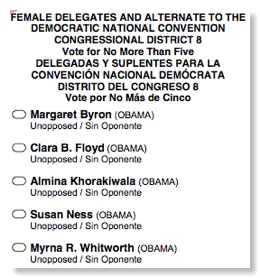
Susan Ness served as an FCC commissioner from May 1994 to May 2001. She is the only commissioner within recent memory who had a strong interest in spectrum policy - although Chmn. Powell certainly also had a special interest in the topic. She hired as an adviser David Siddall, an OET staffer who had previously worked on the Hill. While Dave is not an engineer by training, his excellence in working at OET and with Comm. Ness on spectrum policy issues shows that what is essential in technical policy is a real interest in the topic as well as a willingness to learn.
Here is her official FCC bio:
Susan Ness was appointed to the Federal Communications Commission by President Clinton in 1994. She chaired the Federal-State Joint Board charged with addressing universal telephone service issues, and served as the FCC's senior representative at the 1995, 1997, and 2000 World Radiocommunication Conferences.
Commissioner Ness promoted measures to advance competition domestically and globally, spur new technologies and services, expand economic opportunities, eliminate unnecessary regulation, and reduce regulatory uncertainty. She played a key role in shaping policies for efficient management of the radio spectrum and was a lead member on international matters. She helped forge agreement on the digital television standard and on guidelines to improve the quality and quantity of children educational television programming. She worked to facilitate delivery of advanced telecommunications services to the classroom and community libraries, so that every child -- urban and rural, rich and poor -- can participate in the telecommunications and information revolution.
In recognition of her achievements, Commissioner Ness was chosen as one of four 1999 recipients of the International Radio and Television Society Foundation Award, received the Consumer Electronics Association 2000 Digital Television Leadership Award, and was selected as one of Electronic Media's "12 to Watch in 1997." She has also been honored by Women of Wireless and by the American Women in Radio and Television for her efforts on behalf of women. Rutgers University inducted her into its Hall of Distinguished Alumni in 1998, and Douglass College selected her as a member of the Douglass Society.
Prior to her FCC appointment, Commissioner Ness was a senior lender to communications companies as a group head and vice president of a regional financial institution. She served as Assistant Counsel to the Committee on Banking, Currency and Housing of the U.S. House of Representatives, and she founded and directed the Judicial Appointments Project of the National Women's Political Caucus.
Commissioner Ness is a member of the National Association of Regulatory Utility Commissioners' Committee on Communications, the Federal Communications Bar Association, and Leadership Washington (Class of 1988). Before she joined the FCC, she served in many civic leadership roles, including chair of the Montgomery County, Maryland, Charter Review Commission; vice chair of the Montgomery County Task Force on Community Access Television; and president of the Montgomery County Commission for Women.
Commissioner Ness is a graduate of Douglass College, where she received her Bachelor of Arts degree. There she served on the board of directors of WRSU Radio (Rutgers University). She received a Juris Doctor, cum laude, from Boston College Law School, and a Masters in Business Administration from The Wharton School of The University of Pennsylvania.
Commissioner Ness is married and has two school-aged children.
From 2005 to 2007, she was the founding president and CEO of GreenStone Media, LLC, which produced talk programming targeting women for syndication on radio and other platforms.
She is a member of the J. William Fulbright Foreign Scholarship Board, having been appointed to that position by President Barack Obama in September 2011. She serves on the board of Vital Voices Global Partnership, a nonprofit organization that identifies and invests in extraordinary women worldwide. She is a Senior Fellow at the Center for Transatlantic Relations at Johns Hopkins School of Advanced International Studies (SAIS), and an affiliated expert of the Information Technology and Innovation Foundation (ITIF).
She was Distinguished Visiting Professor of Communication at the University of Pennsylvania’s Annenberg School for Communication, where she taught graduate seminars on domestic and global communications policy, and was Director of Information and Society at the Annenberg Public Policy Center. She is a member of the board of Gannett Co., Inc, (NYSE-GCI). Previously, she served on the corporate boards of LCC International, a global technology firm, and on the post-bankruptcy petition board of Adelphia Communications Corporation. She is vice chair of the J. William Fulbright Foreign Scholarship Board, which oversees the Fulbright scholarship program. She also serves on the board of Vital Voices Global Partnership, an NGO that identifies and invests in extraordinary women worldwide.
Susan, you are missed at FCC and I hope whoever wins the election this year will appoint more people like you to FCC. Maybe as a convention delegate you can add that to the platform!
Spectrum Provisions in P.L. 112-96
On February 22 President Obama signed the Middle Class Tax Relief and Job Creation Act of 2012 (P.L. 112-96) into law. Despite its name, this 101 page bill is one of the more significant pieces of legislation in the spectrum area in several years.
While trying to solve the budget crisis and the economy, Congress could time to give gifts to its favorite industries. One provision that has attracted little attention is Section 6409 which Don Evans at CommLawBog describes as
a small measure of relief in the on-going struggle to get tower modifications approved and constructed. Buried in a collection of odds and ends dumped, seemingly as afterthoughts, at the end of the law, Section 6409 requires state and local governments to approve modifications of wireless towers and base stations as long as those modifications don’t substantially change the dimensions of the existing structures.
As Don points out, this section has little legislative history and deals with preemption issues that raise serious constitutional issues. Nevertheless, local zoning and permitting issues have slowed tower construction and put excess pressure on spectrum as the only solution. Of course, the cellular industry could have tried to hire engineers and architects to develop new tower designs more acceptable to neighbors, but in this case chose back room deals on Capitol Hill. I hope it works out well for them.
GAO is given some new temporary roles in the new legislation. In Section 6408 GAO is told “ to consider efforts to ensure that each transmission system is designed and operated so that reasonable use of adjacent spectrum does not excessively impair the functioning of such system.” This task is explicitly supposed to consider receiver standards, use of adjacent spectrum, and use of guardbands. Perhaps GAO will be able to address the issue of receiver standards that FCC and NTIA have been unable to deal with. In Section 6412 GAO is also told to study the rejection of FCC licenses in the 11, 18, and 23 GHz bands.
Sect 6201-6303 deal with first responder networks and hopefully will break the impasse in this area which has endangered public safety for decades.
Sect. 6403 has the TV incentive auction favored by CTIA and condemned by NAB, presumably with compromises to try to pacify both. The mysterious “unlicensed auction” has disappeared.
Sec. 6406 requires an NTIA study to determine if the U-NII band can be expanded to cover 5350–5470 MHz and 5850–5925 MHz .
Sect. 6601 and 6002 end the odd saga of the Telecommunications Development Fund which was created in the Telecommunications Act of 1996, 47 USC 614, to fund private sector telecom R&D projects with revenue that was a byproduct of FCC auctions. While perhaps a good idea, TDF was implemented badly with declining transparency. For example, search the FCC website for information on it and see how information has decreased over the years to almost no new information. TDF itself seems to be in a serious state of denial about where its funding came from - federal resources. The presence of an FCC-appointed board member at TDF has created serious appearances of conflict of interest and it is just as well that Congress is ending federal funding and granting in dependence to this group. Spectrum Bridge is a recipient of TDF funding and that creates an appearance that it gets unequal treatment from FCC.
Section 6701 expands the role of OMB in federal spectrum management which is a major improvement since the current legislation under which NTIA functions creates a basic conflict about whether NTIA is supposed to focus on the public interest in the needs of the federal spectrum users. There are created within NTIA 2 new entities: the “Technical Panel” and the Dispute Resolution Panel” to deal with federal spectrum relocation issues. Both panels have 3 members: one appointed by FCC, NTIA, and OMB. There is no requirement that they be federal employees, but there is also no pay for these positions. Guess what will happen? In any case, it is a move in the right direction.
Ofcom Chief on Spectrum in an Age of Innovation
I’m going to begin with a quote, and I’d like to see if you can place it:
“Wireless communication is plagued by a shortage of space for new services. As new regions of the radio spectrum have been opened to practical operation, commerce and industry have found more than enough uses to crowd them.”
Any guesses?
It is fact a direct quote from a report of the United States Joint Technical Advisory Committee of 1952.
So we see that spectrum shortages are not a new issue although the FCC of 1952 might have been better structured to deal with them than today’s FCC.
I want to suggest today that the rapidly increasing rate of change in spectrum use – the dynamism in innovation, technology and in market demand – has injected a new urgency into the need to manage spectrum effectively.I’ll argue that, while in general we need greater use of market mechanisms to produce more efficient use, we also need to be both strategic and sometimes straightforwardly pragmatic in our approach.
I was impressed with he parallel treatment of “innovation, technology and in market demand” as well as the point that economics is important, but pragmatism is also key.
The way that spectrum has been allocated and assigned reflected the view that the overall range of use could be relatively easily foreseen and was likely to be fairly settled, with new uses eased in and conflicts managed away over many decades.
Yes, the central planning era of spectrum has left a large impact. Remember that eh Soviet Union was also big into central planning. The fall of that government was not due to a modern day Thomas Jefferson and a band of revolutionaries, rather it was due to total economic failure in a planned economy even it it had the resources of a large nation!
.But public spectrum holdings were until recently largely exempt from any such (economic) pressures, and that imbalance – where one sector faces increasingly clear economic incentives and the other does not – means that the balance between public and private holdings is likely to be far short of optimal. Even with an increasing and very welcome focus from the UK government in addressing this, the incentives for public bodies, agencies and government departments to rationalise their spectrum holdings remain variable
While the US focuses on more spectrum for public safety, this blunt talk admits the fact that the public sector in the UK probably has too much spectrum and is a statement that we are unlikely to hear from the FCC Chairman or NTIA Administrator.
It has been very disappointing to witness the extent to which the incumbent mobile operators have chosen to entangle ... (realignment of mobiles bands) in litigation or threats of litigation.We recognise, of course, the need for companies to defend their commercial interests and to have recourse to the law in order to do so.
If a regulator or any other public authority makes a decision that is either procedurally or substantively flawed, the right of appeal is there to ensure good decisions replace bad ones.But when litigation becomes essentially strategic rather than based on objective grounds, and when it has the effect of holding back innovation and hampering growth, it is legitimate to ask whether the overall legislative framework fully supports the public interest in this increasingly vital area.
A democracy with the rule of law allows litigation to review regulatory decisions. But sometimes this also has an adverse impact on innovation.
The need for change also extends to those who use spectrum adjacent to the new services. In the (U.K.) case of 800MHz that includes Digital Terrestrial Television. For 2.6GHz, it is air traffic control radars. In the past, the response to the huge planning and mitigation issues that arise from this might have simply prompted the conclusion that it was all too hard to fix.
We no longer have that luxury. It would not be in consumers’ interests or in the interests of the wider economy. And it would not reflect the new realities of a world in which even very important and long established spectrum users may have to adapt to the arrival of new and different neighbours.
Is the “public interest” always absolute protection of incumbents? A thought one rarely hears in Washington from public officials.
Finally, Mr. Richards ends with
In the past, spectrum was assigned to users in the expectation that it would be effectively held in perpetuity. This has led consumers to a commensurate expectation about the lifecycle of their equipment. Now, in this new phase, more frequent change may well be necessary to promote more efficient outcomes for everyone.
In spectrum matters, straightforward long range planning will be replaced by adjustment and adaptation to the dynamism of technology and markets, combined with clear strategic coordination and pragmatism in delivery. As we look ahead, these will be the defining characteristics of successful spectrum management.
Doug Sicker:
FCC -> NTIA
Douglas Sicker, Chief Technology Officer and Senior Advisor for Spectrum
Douglas Sicker is NTIA’s Chief Technology Officer and Senior Advisor for Spectrum. He is also an endowed professor in the Department of Computer Science at the University of Colorado at Boulder, with a joint appointment in the Interdisciplinary Telecommunications Program.
Dr. Sicker has held various positions in academia, industry, and government. Before joining NTIA, he was the Federal Communications Commission’s Chief Technologist. Previously, he served as a senior advisor on the FCC National Broadband Plan and, before that, as Director of Global Architecture at Level 3 Communications, Inc.
Earlier still, Dr. Sicker served as Chief of the FCC’s Network Technology Division. After leaving this agency, he served as Chair of the Network Reliability and Interoperability Council steering committee, an FCC federal advisory committee that focuses on network reliability, wireline spectral integrity and Internet peering and interconnection. He also served on the Technical Advisory Council of the FCC. In addition, he has also held faculty and industry positions in the field of medical sciences.
Dr. Sicker is a senior member of the IEEE, as well as a member of the ACM and the Internet Society. He has chaired and served on the program committees of numerous technical conferences including IEEE, DySPAN, ISART and TPRC. His research interests include network and wireless systems, network security, and telecommunications policy. He has research funded through the NSF, DARPA, the Internet Society and the Federal Aviation Administration. He holds a Ph.D. from the University of Pittsburgh. A full CV is available on his faculty page at the University of Colorado at Boulder.

FCC Forum on Indoor Deployments of Small Cell Sites
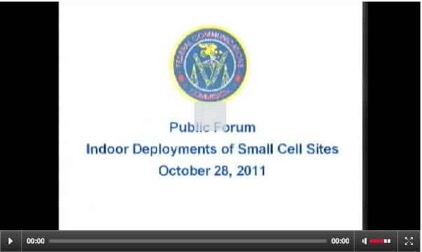
On October 28, 2011 FCC held a Public Forum on Indoor Deployments of Small Cell Sites in the Commission Meeting Room with live video online. The forum was organized by the Wireless Telecommunications Bureau, in conjunction with the FCC's Technical Advisory Committee (TAC) Small Cell working group and Spectrum Task Force. I have been somewhat critical of how little the TAC has been asked to do and how little it has accomplished since its formation, but this was certainly a positive move and the FCC staff and the TAC members certainly deserve credit for bringing public attention to this important issue.
The FCC PN on the event said,
Recent developments in technology offer an increasingly wide array of products to provide wireless coverage and capacity in limited or confined areas. Together, they offer potentially useful solutions to addressing the exploding demand for spectrum that is being driven by the exponential growth in wireless data services. The forum will provide an overview of small cell technologies currently available or soon to come on line, including software defined radios and enhanced Wi-Fi in both licensed and unlicensed spectrum. In addition, panelists will explore the business opportunities and challenges involved in expanding wireless data coverage. Finally, the forum will assess the potential economic impact of small cell deployments, particularly with respect to job creation, and explore possible policy approaches.

That is what was basically discussed and the forum dealt with both femtocells that act as tiny base stations for cells phones indoors and then connect to the network over the internet - effectively limiting CMRS spectrum use to very short distances - and Wi-Fi base station that extend the network to phones and smart phones that have both Wi-Fi and the more usual CMRS modulations. The cellular industry’s love/hate relationship with unlicensed in general and Wi-Fi will be the subject of a future post here - stayed tuned!
What was interesting to your blogger was also what was not discussed. This fell into two basic categories. Will the growth of indoor small cells impact the voracious demand for spectrum of the CMRS gang? Although the official CTIA party line is that spectrum is the only way to solve the “shortfall” and this is dutifully echoed in the FCC’s recent “infographic” , it would appear that the technologies discussed at the forum would also have an impact on spectrum needs. As we have stated before here, wireless capacity is a function of 3 factors: spectrum, technology, and infrastructure. The speakers successfully evaded this issue.
A second issue is whether femtocell technology should only be used for connections to the public switched network or Internet using standard CMRS modulations. Today’s cellular industry is focused on “killer apps” like iPhone that can affect there bottom line in massive ways and has little or no interest in niche markets. For several years your blogger has been trying to interest cellular carriers and manufacturers in using variants of femtocell technology to meet niche applications that otherwise would require dedicated bands.
Independently, Qualcomm began and R&D project exploring such an complementary use of cellular spectrum and earlier this year announced it as FlashLinq™which “operates in licensed spectrum as a managed service”. This is an example of using short distance links in CMRS spectrum to meet needs not served by traditional CMRS services such as short range communications. While unlicensed spectrum might be used for such uses, CMRS spectrum under carrier control offers the potential of much higher reliability. It would both fill the “white space” that is inevitable in an operational cellular spectrum and created new revenue for the carriers. Services that might be provided include wireless microphone services where a high density is required such as in theaters and concerts and medical information in hospitals where great reliability is needed. But such niche services are not “killer apps” in the eyes of the CMRS top leaders.
Well, here is another way to look at it: Niche markets like wireless microphones and medical uses all have as their preferred solution dedicated exclusive spectrum. We have seen more medical allocations in the US in recent years and other countries have dedicated wireless mic bands. Maybe the leaders of the CMRS community should not look at these applications and innovative technology such as FlashLinq not as a modest revenue source but as a way to eliminate spectrum competitors who are competing at FCC’s trough for the same spectrum the CMRS community seeks. So it may not matter if such applications are not “killer apps” if serving them in existing CMRS spectrum eliminates another roadblock to increased CMRS spectrum.
Regulatory Uncertainty and Investment in Wireless R&D
On the question of why wealth is not creating new jobs, Ryan stated the causes were
(U)ncertainty on taxes, uncertainty on regulation, uncertainty on debt, and therefore borrowing costs, interest rates and things like that. there is so much government induced uncertainty that it is putting a massive chilling effect on growth. I think that is something we can fix. That is something we can be focusing on as public policy leaders to fix one of the sources of instability, of uncertainty, of one of the depressors of economic growth. (0:50 - 1:26)
Businesses need to have to have some degree of certainty if they are going to plan and take a risk. We want to encourage risk taking. We want to encourage people to take their capital and put it to work, not put it in a bank, not put it in a bond, put it in a factory, put it in a business plan that increases employment. (1:50 - 2:10)
Similarly, the FCC’s longstanding de facto policy of indecision and delay on deliberations on new spectrum policy or whether new technology would cause ”harmful interference” on incumbent licensees results in huge regulatory uncertainty for capital formation in innovative wireless technology. Coupled to this is the Commission’s continual denial that Section 7 is part of the “law of the land”, a repeated topic on this blog. (Section 7 is not a perfect piece of legislation. But if the Commission feels it is unworkable as written, the proper procedure is to request repeal or modification -- not ignore it.)
Wireless R&D is not the only thing a tech savvy investor can invest in. There are less regulated fields like semiconductors, display technology, energy technology, and even biotech - many investors would prefer FDA-regulated technology over FCC-regulated wireless technology because FDA despite its many problems is more transparent that FCC Title III technical regulation! FCC uncertainty and delay adds to other investment risks and may make wireless technology R&D too risky for any rational investor.
While this discussion focuses on technological innovators and incumbents are sitting “fat and happy” with their ability to delay and tilt FCC new technology deliberations in their favor, they also face a risk that capital markets might someday realize that the huge value of their Title III licenses depends on the “metes and bounds” of these assets and in the present nontransparent system this raises regulatory uncertainty for the incumbents and hence increase investment risk. Increased transparency may be more credible to investors than K Street law firms on retainer to defend against innovators.
Spectrum Wars Heat Up
Although I agree with much of what is said in the Infographic, this is the most complex piece of graphic design I have ever seen at FCC and may be the triumph of form over substance. It appears to have been contracted for with an outside design house, Lab42, which states on its website:
Behind every great infographic is great data, which is where Lab42 excels. The infographics we create are powered by the data collected from our very own market research studies, meaning each of our infographics is unique. If you choose to work with Lab42, you can be sure that your one-of-a-kind infographic will be customized to meet your needs and the data behind it will be exclusively yours.
The Infographic starts with this statement:
It then goes on to say:S P E C T R U M is the public airwaves, which Americans use every day. Without spectrum, you can’t make cell phone calls, download digital textbooks, email on your smartphone, download an app to your tablet, use a remote control, or listen to the radio?
Without additional spectrum EXPECT DELAYS more dropped calls & slower download
Under “What does spectrum matter” it states that there will be 771,000 jobs created by 2015, crediting a “study by Deloitte” that is not cited further either on the Infographic or the accompanying PN, so we can’t see what the assumptions were.

What the digital economy needs is not spectrum but capacity furnished in a cost-effective manner. Now new spectrum for the CMRS crowd may well be part of the solution, but it is not necessarily the whole solution. The above chart points out that spectrum, technology, and topology (infrastructure) are all contributors to capacity. The CMRS crowd has a single minded focus on the spectrum issue and the new Infographic seems to have the FCC following hook line and sinker. The FCC’s apparent indifference to wireless innovation, as shown by the 4+ years it fussed with AWS-3 without even reaching a conclusion on the technical issues and its inaction on its own Wireless Innovation NOI will probably guarantee that capital formation for such wireless innovation in this country will dry up so the CMRS crowd can focus on equipment designed in Europe and manufactured in China.
The Coalition For Free TV and Broadband is “a group of television broadcasters, concerned organizations, and individual citizens and has formed to ensure the survival of free television and to offer solutions to the nation for better, cheaper wireless broadband utilizing the broadcast industry.” Although Sinclair Broadcasting does not appear to be a member of this group, its executives are clearly speaking in favor of it. In the past Sinclair has been critical of the ATSC VSB technology for DTV and favored the European-like OFDM alternative.
White details of the Coalition proposal are somewhat vague, they describe it as follows:
With regulatory changes that would be trivial to implement, broadcasters could deliver a substantial and perpetual revenue stream to help offset budget deficits while alleviating the most significant cause of mobile broadband congestion. The driving factor of the looming spectrum crisis is the rapid growth in use of mobile video services. Projections of a spectrum shortage assume that all mobile video will be provided on a “point-to-point” basis: more than half of all mobile data traffic is expected to be video services. Today, if 100,000 people watch a football game, wireless carriers must provide 100,000 separate streams. The same game provided by a broadcast architecture would require only one stream – every user can access the same stream. The spectrum efficiency gains of broadcast for video delivery, as compared to individual streams on wireless networks, are vast.
If broadcasters are permitted to enhance their technology to seamlessly integrate with mobile devices, vast amounts of mobile data demand can be offloaded from the wireless networks. And the revenue generated from ancillary data services can generate far greater receipts to the Treasury than a one-time auction.
Of course, the claimed efficiency depends critically on whether people want to use their cell phones to watch real time programming simultaneously or want to watch video on demand. The Coalition proposal has some similarity to the late Qualcomm MediaFLO system that was a commercial failure.
The Coalition gives the following advantages for their plan:
I can not find a public statement by CTIA on this plan although Broadcasting & Cable found an NAB quote merely saying ”it is studying the Coalition proposal, which offers interesting ideas worth reviewing.”If embraced by Congress and the FCC, the Coalition Plan would:
•Avert a spectrum shortage by providing a vastly more efficient way to deliver the bandwidth-intensive broadband traffic
•Lead to lower prices for mobile broadband data while improving service quality
•Eliminate the need for incentive auctions, protecting Americans who rely on full power and low power broadcast television from loss of service.
•Provide more than $60 billion in new revenue to the U.S. Treasury in the first fifteen years, far more than the projected net proceeds from incentive auctions.
•Provide a perpetual revenue stream that could be worth as much as $216 billion to the U.S. Treasury.
UPDATE
A Tweet from CTIA announces “Study confirms spectrum crunch for wireless” and points to this report from the Global Information Industry Center at the University of California, San Diego. But in in line with the Ofcom report on the 3 building blocks of wireless capacity, the cited report also points out:
Enable deployment of supporting infrastructure.
Mobile services require towers and other support structures for antennas, lines and microwave dishes to “backhaul” the traffic from the cell site to the central network and switches, power, and secure locations for the equipment. Installing these facilities requires permits, construction and community support. The more we consume wireless data, the higher the number of cell sites will be needed to increase the capacity and improve reliability. If we want to continue to have access to reliable wireless services, we must be willing to support this construction. This needs to be an explicit choice made by the community.
Headline: NAB and CTIA Agree on Something!
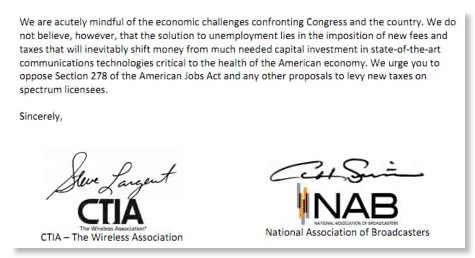
An e-mail from NAB arrived today with the letter which ends as shown above. My first thought: Wow! NAB and CTIA actually agree on something! After feuding all year on the silly issue of FM receivers in cell phones as a way to settle an NAB/RIAA squabble, not to mention the incentive auction legislation, they are finally in agreement and both million dollar CEOs signed the same document!
Readers may recall that I introduced the spectrum provisions of the Obama Jobs Bill last month. Although incentive auctions got all the attention, there are a number of other provisions. The White House summary I cited, has the following description of the Section 278 that the Goliath’s fear so much:
“Subparagraph (A) requires the FCC to conduct a rulemaking to establish a fee methodology and a fee collection schedule. The FCC is directed to develop a fee methodology consistent with the public interest, convenience, and necessity requirement, which is found throughout the Communications Act. The FCC is expected to undertake a multi-stage rulemaking during which fees for different classes of spectrum licenses or construction permits may be developed and phased-in over time, consistent with sound spectrum management principles. It is expected that fees would encourage efficient allocation and use of the radio spectrum, as the opportunity cost of spectrum resources would be reflected to commercial license holders that did not receive authorizations through competitive bidding...Subparagraph (E) provides an exemption from spectrum licensing fees for holders of licenses for broadcast television and public safety radio services.”
So what NAB and CTIA both agree upon, with SIA, NRB, and PCIA, is they don’t want to pay more fees for their spectrum that wasn’t obtained by auction. Presumably this is the same CTIA that was opposed to M2Z getting a license without auction but with a major free service requirement.
But, I guess nobody likes to pay more taxes!
How Do You Count to 500?
On February 24, 2010 Chairman Genachowski announced in a speech at the New America Foundation:
“First, we are going to announce a gameplan to unleash more spectrum for mobile broadband. The National Broadband Plan will set a goal of freeing up 500 Megahertz of spectrum over the next decade. We will work closely with NTIA to do so.”
CTIA had previously stated
So the 500 MHz no doubt was a compromise number that attempted to address reality.“we need at least another 800 MHz within six years to meet the increasing consumer demand whether it's for mobile Internet, mHealth, smart grids, or a number of other wireless uses that change the way we live and work."
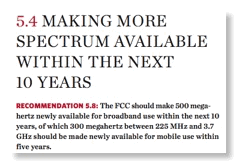
Traditionally the cellular industry has used full duplex symmetrically pair spectrum. Thus the cellular 800 MHz band is 824-849 MHz (mobile-to-base) paired with 869-894 MHz (base-to-mobile). The same type of symmetric pairing was used for PCS and 3G in high bands. This was clearly necessary when the predominant use of cellular was 2-way voice which has little tolerance of time latency/delay. But the rapid expansion of mobile communication volumes predicted by CTIA and the NBP are not 2 way voice, rather they are Internet and video related - categories that are asymmetric in information flows and more tolerant in time latency. Many of these flows are also highly intermittent as compared to voice, with high peak to average data rates. Is the traditional type of allocations the best way or the only way to handle this type of growth?
Your blogger has no objection to the reallocation of 500 MHz of spectrum for the traditional paired symmetric use, but it is becoming increasingly clear to all involved that finding 500 MHz of such spectrum will be in the extremely difficult to nearly impossible range. In addition, the major need for spectrum is in major metropolitan areas and the focus on nationwide availability of spectrum ignore options. From what I have heard, the cellular establishment wants FCC and NTIA to find it spectrum that has all the following characteristics:
- Nationwide full time availability
- Paired
- In large contiguous blocks
- Consistent with international allocations and international standards (note that this is not a legal requirement except near borders with Mexico and Canada absent a bilateral agreement)
So isn’t it time to start thinking of Plan B? If 500 MHz of spectrum meeting the cellular establishment’s 4 conditions can not be found with politically acceptable impact on other federal and nonfederal uses, how would “noncomplying” spectrum count towards the 500 MHz goal? Maybe for tactical reasons the cellular establish doesn’t want to consider this possibility, but to many of us it is a quite real possibility as none of the “spectrum haves” are anxious to release their part of the 500 MHz or have any impact from its altered use, e.g. GPS/LightSquared problem.
CBO knows how to “score” budget proposals, should FCC and NTIA start thinking about how to “score” spectrum reallocations with respect to the 500 MHz goal?
[I help my international neighbors by reading in English to their 4 year old. While I was writing this post, one of the books he selected was this one.I recommend it!]
Spectrum Innovation Act of 2011:
Will the Party in Favor of Section 104 Please Stand Up?
The draft deals with several topics. FastNetNews published a Republican staff memo which is a good summary. The Republican staff summarizes the bill’s contents as:
The first is a discussion draft that authorizes an as yet unspecified amount for construction of an interoperable public safety network on the 24 MHz of spectrum cleared for public safety by the 2005 DTV legislation, creates a governance structure for construction and operation of the public safety network, and authorizes incentive auctions.
However, what got a lot of attention at Thursday’s meeting was Section 104 which the staff described as follows:
Requires that any spectrum made available for commercial use must be done so through auction, regardless whether the spectrum is to be made available on a licensed or unlicensed basis. If the sum of the bids of the parties that prefer unlicensed use of particular spectrum exceeds the highest individual bid for licensed use, the spectrum will be made available on an unlicensed basis. This approach is modeled after FCC Office of Strategic Planning Working Paper No. 43. This section also requires new unlicensed devices to coordinate with a database to determine which spectrum bands are available for operation..
CTIA is rumored to be the proponent of this provision, but CTIA’s Christopher Guttman-McCabe’s testimony on Friday never mentions “unlicensed” at all. Indeed, it isn’t clear if anyone is publicly in favor of this provision, yet it somehow appeared in the bill. Would whoever is in favor of Section 104 please stand up and tell us why it is a good idea?
Note that the legislation would apply to ALL new unlicensed bands. It assumes that all bands are the same and could be equally used for licensed or unlicensed use. Note that for the case of the ISM bands used for Wi-Fi and Bluetooth, the band use is secondary to both ISM devices (e.g. microwave ovens), military radars, and amateur radio use. Not much demand for licensed use here is there! The 57-64 GHz band is shared with federal government use and is subject to odd radio propagation due to absorption by oxygen molecules that limits useful ranges to less than a mile. Again not a hotbed of licensed interest. So why is this a good idea for all unlicensed bands?
Most unlicensed bands are really “damaged goods”. The unlicensed community has made something useful out of bands where they had great technical flexibility to innovate. While giving the FCC the option of use auctions in making licensed/unlicensed decisions might be a good idea for bands that are not damaged goods, requiring it in all cases is really a bad idea.
If the committee is so interested in “innovation”, why doesn’t it ask why Section 7 is broken?
UPDATE
GigaOm has a piece on the topic of Section 104 with the title “How Congress’ spectrum bills hurt the tech community”. The URL implies a stronger viewpoint: http://gigaom.com/broadband/how-congress-spectrum-bills-screw-the-tech-community/ It includes this interesting observation:
There’s another wacky issue with unlicensed spectrum — all of the airwaves would be auctioned off in geographic blocks which means that there would be no nationwide unlicensed spectrum block created. So even if local communities or corporate entities interested in promoting unlicensed spectrum bought out the airwaves, they’d only have access to the ones in their local areas. This is how wireless providers buy their spectrum, and it can lead to some operators having a hard time covering certain markets. And while a local municipality might want to buy unlicensed spectrum to offer its citizens Super Wi-Fi or another service over those airwaves, getting low-cost devices for only one area would be a challenge. Device makers can’t provide cheap electronics for smaller markets.
GigaOm, with its much greater resources than your blogger, also doesn’t know who is pushing this bill.
Another viewpoint: A GOP Own-Goal on Spectrum Policy from Forbes blog
New Cellular Advocacy Group Trivializes Spectrum Policy Issues
A new group, Mobile Future,
is dedicated to educating the public and key decision makers on innovations in the wireless industry that have transformed the way Americans work and play and to advocate continued investment in wireless technologies. We look forward to keeping you in the loop about our news and events.
It apparently is trying to do this by producing PR that trivializes key spectrum issues, rather than encouraging productive dialogue on the issue or even improving the governmental decisionmaking process.
Mobile Future is a mixture of cellular industry groups that partially overlaps the CTIA membership and some public interest groups. The industry membership includes AT&T, T-Mobile, Alcatel-Lucent, Qualcomm, Cisco, and Ericsson but does not include Sprint, Verizon, Nokia, or Motorola. Other members include Black College Communication Association, Labor Council for Latin American Advancement, National Gay and Lesbian Chamber of Commerce, and the National Association of Neighborhoods. You can be pretty sure that the first group of members named above are paying the bills and the second groups is there for “window dressing”.

Note that the “pie” shown here, only includes spectrum used by the sponsors with the except of “radio and TV” - would that spectrum management be so simple. In reality there is military use, there is FAA use, there is local, state, and federal public safety use. There is even amateur radio use, not to forget radio astronomy.
But is mobile capacity really proportional to available spectrum? We will not here get into the previously reported NAB and CTIA battling reports. Your blogger is closer to CTIA on that issue than NAB. But the Mobile Future viewpoint is just too much to swallow.
Ofcom, FCC’s well respected UK counterpart, released in January a report entitled 4G Capacity Gains. The study starts with a bold and simple statement that is usually fuzzified in the US cellular industry’s presentations:

- Technology – the cell spectrum efficiency that can be realised by a given feature set
- Spectrum – the bandwidth allocated to a network
- Topology – the mixture of cell sizes and local environments in the network
The report concludes,
“ technology improvements alone will not meet forecast demand increases and that a mixture of changes in topology and spectrum will be required to meet this increase in demand. It is recommended that previous studies into the dimensioning of future spectrum requirements for 4G networks are revisited with the revised cell spectrum efficiency results recommended by this study in mind.”
Thus spectrum alone is not enough to solve the problem, changes in “topology” or number of cells is critical to meet capacity goals.
How is the US doing in this area? A topic the mainstream cellular industry doesn’t like to talk about. Here is one observer’s viewpoint.
FastNetNews reports
Robin Bienenstock of Bernstein makes clear why the U.S. has wireless issues: less investment. “Let's take California and Spain as an example. Telefonica has some 33,000 base stations in Spain (yes, miserable, economically imploding Spain). Conveniently, California is a similar size, has a similar topography, and has very similar population density.”
Yes, the cellular industry need more spectrum. But a singular focus on spectrum ignores the need for more infrastructure and improved technology. Indeed, the Commission’s sometimes indifferent view towards new technology and the capital investment needed to develop it is also a detriment to more wireless services to serve society and help the economy. Finally, the singular focus on spectrum is leading to more and more “food fights” over spectrum that FCC (and NTIA) is/are unable to resolve in a timely way.
UPDATE
Apparently, the real CTIA is perfectly capable of trivializing spectrum policy also. here is a tweet that CTIA sent out several times on July 22:

A Tribute to Sen. Snowe - A Supporter of Rational Spectrum Policy
This week Sen. Olympia Snowe (R-ME) announced her intention to retire from Congress. Her official bio states “Focusing her attention on efforts to build bipartisan consensus on key issues that matter to Maine and America, Snowe has built a reputation as one of the Congress’ leading moderates.” CNN’s appropriate headline was “Citing partisanship, Snowe stuns with departure news”. ABC quotes her as saying about her decision,
“As I have long said, what motivates me is producing results for those who have entrusted me to be their voice and their champion, and I am filled with that same sense of responsibility today as I was on my first day in the Maine House of Representatives. I do find it frustrating, however, that an atmosphere of polarization and ‘my way or the highway’ ideologies has become pervasive in campaigns and in our governing institutions.
“With my Spartan ancestry I am a fighter at heart; and I am well prepared for the electoral battle, so that is not the issue. However, what I have had to consider is how productive an additional term would be. Unfortunately, I do not realistically expect the partisanship of recent years in the Senate to change over the short term.”
As a former “Massachusetts moderate Republican” myself, I will miss this breath of fresh air that is increasingly rare in today’s politics.
Sen. Snowe has been very active in promoting spectrum legislation. She introduced incentive auction legislation in March 2011. In July 2010 she introduced the Spectrum Measurement and Policy Reform Act. In March 2011 she introduced a bill to allow commissioners to appoint technical advisers and require the National Academy of Sciences to study the FCC's technical policy and policymaking decisions and the personnel available to inform those decisions. She also was active on legislation to limit taxes on cell phone use.
One of Sen. Snowe’s great contributions to spectrum policy deliberations was having a knowledgeable staffer, Matt Hussey, who spent a lot of time on spectrum issues and was very accessible to a wide range of people as he sought out a variety of viewpoints for her office.
Sen Snowe contributed greatly to spectrum policy issues and will be missed. Here is a great interview with her on a wide number of issues, unfortunately not including spectrum:
FCC Workshop on Spectrum Efficiency and Receivers
As part of the Commission’s efforts to enhance the use of spectrum for mobile broadband, the FCC Office of Engineering and Technology, in conjunction with the Wireless Telecommunications Bureau and the Office of Strategic Planning will host a workshop on "Spectrum Efficiency and Receiver Performance." The workshop will be held on Monday, March 12, 2012 and Tuesday, March 13, 2012, in the Commission Meeting Room at FCC Headquarters in Washington, DC.
The role of receivers in enabling access to spectrum for new services implicates federal stakeholders, as well as the private sector. Receiver performance issues have often arisen as a conflict between legacy stakeholders and new entrants where deployment of new technologies and services threatens to adversely impact an incumbent or place restrictions on the new entrant. Past examples include interference issues between new cellular radio systems and public safety radio systems, satellite digital radio systems and proposed terrestrial data services, unlicensed WiFi systems and FAA weather radar systems, and ancillary terrestrial service on mobile satellite spectrum and GPS. The resolution of such matters has historically required a public process involving regulators, stakeholders and other parties. Because such discussions sometime begin upon the introduction of a new service or technology, full deployment of such new services could be hindered. New approaches to spectrum management focusing on spectrum efficiency and receiver performance may enable more assured deployment of new services and reduce the necessity for the involvement of regulators.
This two-day workshop will discuss the characteristics of receivers and how their performance can affect the efficient use of spectrum and opportunities for the creation of new services. Key topics will include current practices for receiver design, case studies involving interference due to receiver characteristics, and approaches for promoting interference avoidance and efficient use of spectrum, given the current receiver base and potential future deployments. The workshop will include perspectives from licensees, equipment manufacturers, component providers, and other interested parties.
Apparently there will be panels of speakers, but they have not been announced. Nor has any sort of agenda beyond the above been announced.
(I was surprised by the mention of “unlicensed WiFi systems and FAA weather radar systems” as I have previously written this appears NOT to be a receiver problem, but rather an SDR security issue for the unlicensed cognitive radio systems. Oddly, my September 2011 appeal of an initial redaction of a FOIA request has never been acted on by FCC/OGC. I believe the requested document with fewer redactions would confirm the real nature of the TDWR problem. Motorola is fighting the release of the document with fewer redactions in a “reverse FOIA” action.)
My suspicion is that there is a major coordination problem among the various power that be within FCC on both the agenda and the speakers, probably in their attempt to pacify various industry sectors who have their own view of the issue. Perhaps there is an NTIA problem also.
NTIA has classically been in favor of receiver standards, claiming they have them for federal systems. (Mostly true.) However, NTIA has been unwilling to pressure FAA into adopting 20 year old ICAO Instrument Landing System receiver immunity standards that are used around the world and has been strangely silent on the issue of GPS receiver standards.
In any case, it seems rather strange to have a 2 day workshop with no published agenda 3 working days before it starts.
UPDATE
The afternoon of March 9, the agenda was released.
UPDATE 2
The Powerpoint presentations used are available now on the (ever chaotic) FCC website.
Here are the videos of the 2 days:
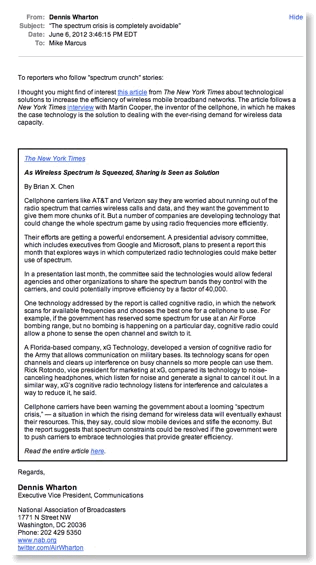
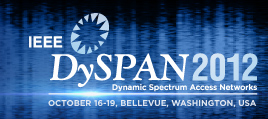

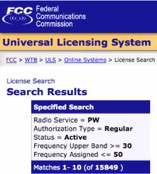


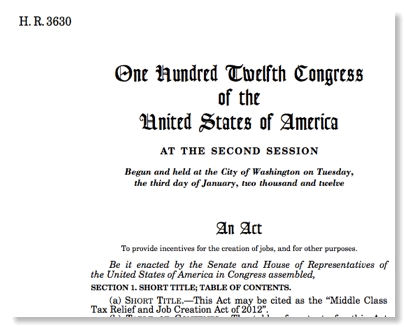





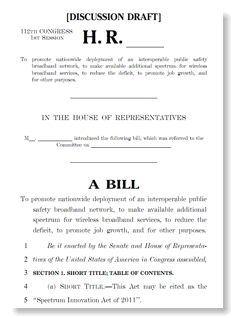
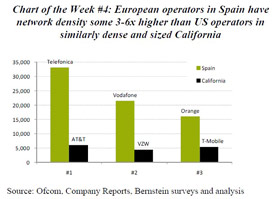
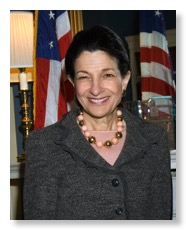
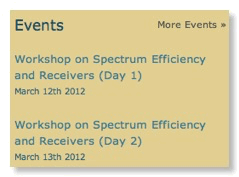



![Validate my RSS feed [Valid RSS]](valid-rss-rogers.png)

